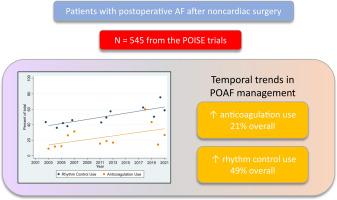Temporal Trends in the Management Practices of Clinically Important Perioperative Atrial Fibrillation After Noncardiac Surgery
IF 2.5
Q2 CARDIAC & CARDIOVASCULAR SYSTEMS
引用次数: 0
Abstract
Background
Clinically important perioperative atrial fibrillation (POAF) is a common cardiac complication after noncardiac surgery. Little is known about how patients with POAF are managed acutely and whether practices have changed over time.
Methods
We conducted an observational substudy of patients who had POAF, were at elevated cardiovascular risk, and were enrolled in the PeriOperative Ischemic Evaluation (POISE)-1, 2 and 3 trials between 2002 and 2021. POAF was defined as new, clinically important atrial fibrillation occurring within 30 days after surgery. We assessed the use of rhythm-control and anticoagulation treatment in response to POAF, at hospital discharge and at 30 days after surgery. We assessed for temporal trends using multivariable logistic regression.
Results
Of the 27,896 patients included, 545 (1.9%) developed clinically important POAF. Patients received rhythm-control treatment in 48.6% of cases. The level of use of rhythm-control treatment increased over the course of the trials (POISE-1 vs POISE-2 vs POISE-3; 40.9% vs 49.5% vs 59.1%). A later randomization date was associated independently with use of rhythm-control treatment (odds ratio, 1.05 per year; 95% confidence interval, 1.01-1.09). Anticoagulation treatment was prescribed in 21% of POAF cases. The level of anticoagulation treatement use was higher in POISE-3, compared to that in the 2 previous trials (POISE-1 vs POISE-2 vs POISE-3—16.4% vs 16.5% vs 33.6%). A later randomization date was associated independently with use of anticoagulation treatment (odds ratio, 1.06 per year; 95% confidence interval, 1.02-1.11).
Conclusions
Despite the absence of randomized controlled trials, the level of use of rhythm-control and anticoagulation treatment for POAF is rising. High-quality trials are needed urgently to determine whether these interventions are safe and effective in this population.

非心脏手术后临床重要围手术期心房颤动管理实践的时间趋势
背景具有临床意义的围手术期心房颤动(POAF)是非心脏手术后常见的心脏并发症。我们对 2002 年至 2021 年期间参加围手术期缺血评估 (POISE)-1、2 和 3 试验的 POAF 患者进行了观察性子研究,这些患者心血管风险较高。POAF 被定义为术后 30 天内发生的新的、有临床意义的心房颤动。我们评估了出院时和术后 30 天内针对 POAF 使用心律控制和抗凝治疗的情况。结果 在纳入的 27,896 例患者中,有 545 例(1.9%)出现了具有临床意义的 POAF。48.6%的患者接受了节律控制治疗。使用节律控制治疗的比例在试验过程中有所增加(POISE-1 vs POISE-2 vs POISE-3;40.9% vs 49.5% vs 59.1%)。随机日期越晚,使用节律控制治疗的比例越高(几率比为每年 1.05;95% 置信区间为 1.01-1.09)。21%的 POAF 病例接受了抗凝治疗。与之前的两项试验相比,POISE-3 的抗凝治疗使用率更高(POISE-1 vs POISE-2 vs POISE-3-16.4% vs 16.5% vs 33.6%)。结论尽管缺乏随机对照试验,但针对 POAF 的节律控制和抗凝治疗的使用水平正在上升。迫切需要进行高质量的试验,以确定这些干预措施在这一人群中是否安全有效。
本文章由计算机程序翻译,如有差异,请以英文原文为准。
求助全文
约1分钟内获得全文
求助全文
来源期刊

CJC Open
Medicine-Cardiology and Cardiovascular Medicine
CiteScore
3.30
自引率
0.00%
发文量
143
审稿时长
60 days
 求助内容:
求助内容: 应助结果提醒方式:
应助结果提醒方式:


